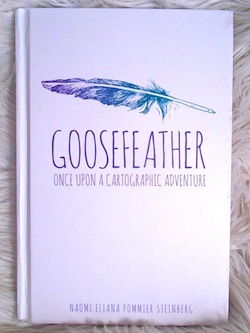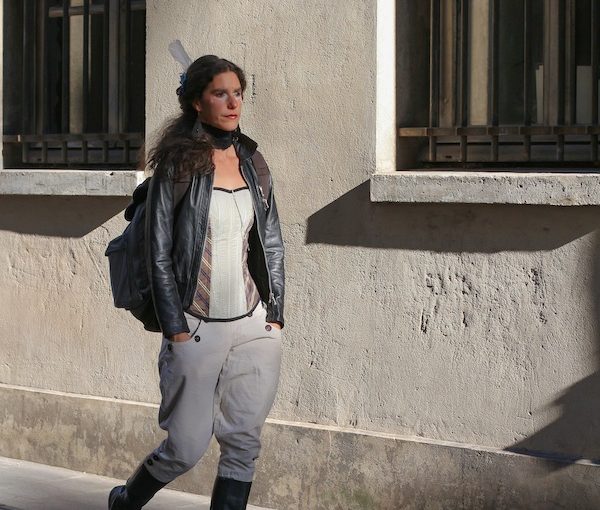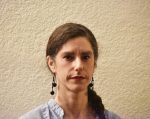Storyteller Naomi Eliana Pommier Steinberg’s years-long Goosefeather journey has taken her around the world. This photo was taken in Paris in 2015. (photo © lineka)
A travelogue of observations and experiences from the unique to the mundane, the personal to the universal, a mix of prose and poetry, Goosefeather: Once Upon a Cartographic Adventure has arrived. Its journey, which started in 2011 when storyteller Naomi Eliana Pommier Steinberg interviewed her grandfather in Paris, will culminate in a book launch in Vancouver on June 9 that will stream live on Facebook and YouTube.
Vancouver-based artist Steinberg asked her maternal grandfather, who was not Jewish, more than 100 questions. In particular, she told the Jewish Independent in a 2018 interview, “I wanted to know how he had helped my Jewish grandmother survive the Second World War and why he was a collector of maps, weights and scales. Given his work with the metric system, I also thought it would be interesting for us to talk about measurements in general.” (See jewishindependent.ca/around-the-world-in-382-days.)
More than a year of research followed and, while she was able to show her grandfather pieces of what would become the performance work Goosefeather, he passed away before the work was completed. The JI saw the 2014 Vancouver Fringe Festival show, in which, the article notes, “Steinberg intersperses what she knows and learns about her grandfather with observations about the concept of measurement, of time and space. What do we measure? Our waists, our burdens? What are our favourite measuring tools? A yardstick, the position of the sun?” (See jewishindependent.ca/jewish-flare-at-fringe-festival.)
The idea that there is no such thing as an exact measurement is accented in the book Goosefeather, as an opportunity for readers to consider what they don’t know, to accept and embrace the unknown, and the fact that there will always be a margin of error, not just in our measurements, but in our perspectives and approaches to life.
“What I arrive at in the book is that: ‘Practising right-relation is predicated on allowing space for not knowing, space for humility, space for listening.’ It is a term borrowed from Buddhism,” Steinberg told the Independent in an interview last week.
“In Judaism,” she said, “there is kavanah, the stilling of self to prepare for entering the mystery. The setting of intention. Before ritual gestures, we centre ourselves, humble in the light of all there is, intending to practise peace. For some, the experience is made desirable and the longing for union acute through visualization. Then, I believe that tzedakah is one of the ways we can practise right-relation. With my own liberal interpretation and limited understanding, I could say that Judaism wrote laws to ensure the circulation of wealth, including, for example, tithing and taxation systems. Tzedakah, charity, is a mitzvah – a very important good deed. Finally, slichot [forgiveness prayers], the ability to recognize what is important … what needs to be let go, instead of focusing on negatives.”
The ability to adapt, to make quick decisions and to remain positive serve Steinberg well as a storyteller, no doubt. These attributes also helped on her travels, where things didn’t always go as planned, or were even left unplanned until the last minute. Her 382-day journey – by almost every mode of transportation except airplane – covered just under 56,000 kilometres and took her to many countries, including Canada and the United States, as well as Australia, China, Japan, Russia, Norway, England, Scotland, France, Switzerland and Belgium. She performed Goosefeather, as well as did other storytelling, along the way – 37 productions in all, according to the press material.
From countless experiences, Steinberg has created a concise account that is informational, philosophical, lyrical and thought-provoking. Some days, she records the details of her travels; other days, she ponders larger questions; yet other days, she simply notes how something smelled or sounded.
“An itinerant artist is a human on the road,” she explained. “There are ups and downs on life’s road. Parts of the 382 days on the road were uncomfortable or stretched out, long and slow. Well, we know it’s not all just fun and games in life. I wanted to keep it real. Much of what I was trying to do by sharing those moments was enter the banality of the day-to-day; to bring readers’ bodies there, evoking images, awakening senses, remembering experiences. That’s what storytellers do!”
Steinberg not only performed during her travels, but gave workshops, in which she offers her experience in crafting a story to communications professionals and other groups, stressing the importance of play and movement.
“The diaphragm is a great muscle that holds a lot of tension,” she explained. “It works super-hard every day, as does the heart, to maintain a flow of oxygen to all parts of the body. That’s amazing. We can practise gratitude towards our bodies every day! Sometimes, the tension in the diaphragm can be released through conscious breathing, laughter, certainly through yawning, and, probably, hopefully, through crying. These are four good ways to release the diaphragm. When we play, the diaphragm gets shaken up a bit and we can relax. Try it!
“Play is fun, charming, disarming. Play is guileless. Otherwise, you may as well call it manipulation and dress it up in propaganda’s clothes. Play can be surprising, logic threatening, synaptic gap leaping. These transformations in perspective can be subtle yet profound.”
Such thoughts come full circle back to the concept of margins of error and how our recognition of their existence could make us less quick to judge and more open to others’ ideas and perspectives.
Steinberg cited American writer and translator X.J. Kennedy, who, she noted, “says: ‘To leap over the wall of self, to look through another’s eyes – this is valuable experience, which literature offers.’
“Lateral movement is good for the body,” said Steinberg. “In theatresports, there is a game called space-jump – you literally leap in and out of scenarios, putting your whole self in an imaginary situation. Playing this feeds agility, spontaneity and willingness.”

Books, she said, are essential for many people, including, or perhaps especially during difficult periods, such as the COVID-19 pandemic we are currently experiencing. “Escaping into other experiences, or trying to understand what’s happening through the lens of historical accounts, can be a kind of lifesaver,” she said. “Books provide solace in challenging times. The act of writing can record, reflect and frame.”
Describing Goosefeather as “a memoir and travelogue with literary aspirations,” Steinberg said, “I have tried to bring my strength as an oral storyteller from the stage to the page. I hope the readers of Goosefeather feel included in a process of emergence and discovery. That a lightness and delight is found in the journey and that there is emotional resonance with humanity and with the planet. In some ways, I want to position the book as an antidote to the propagation of fear and the dangers of isolation.
“We are living a tremendous story of transformation,” she said. “The most gripping stories I’ve listened to or read, the ones that were somehow useful to my psyche, were the ones that gave insight into how a character might navigate difficulty, or might share their love and appreciation for what makes life wonderful. Listening, generosity, caring … these are manifest around the globe in a thousand small gestures and are giving shape to our emergent global culture. My hope is that Goosefeather’s story, her journey around the planet, contributes to this.”
And is that journey now complete?
“I like the idea that the performance is over, and need that for my own closure,” said Steinberg. “It ensures celebration of achievement. I can say, ‘Done’ – journey around planet as singular gesture towards time-space, ‘check!’
“Then there is the show, which I suppose could be performed again, but I’d have to relearn the text fresh and new. I’ve toyed with the idea of Goosefeather’s character doing a different stage performance, but, truth be told, I don’t actually know what comes next after this book! Maybe someone will pick it up and help with soft cover distribution? For now, I have 500 hardcover, first-edition, silver-gilded books for sale, and the desire to produce an interesting and entertaining live-stream launch event.”
To learn more, visit goosefeather.ca.


